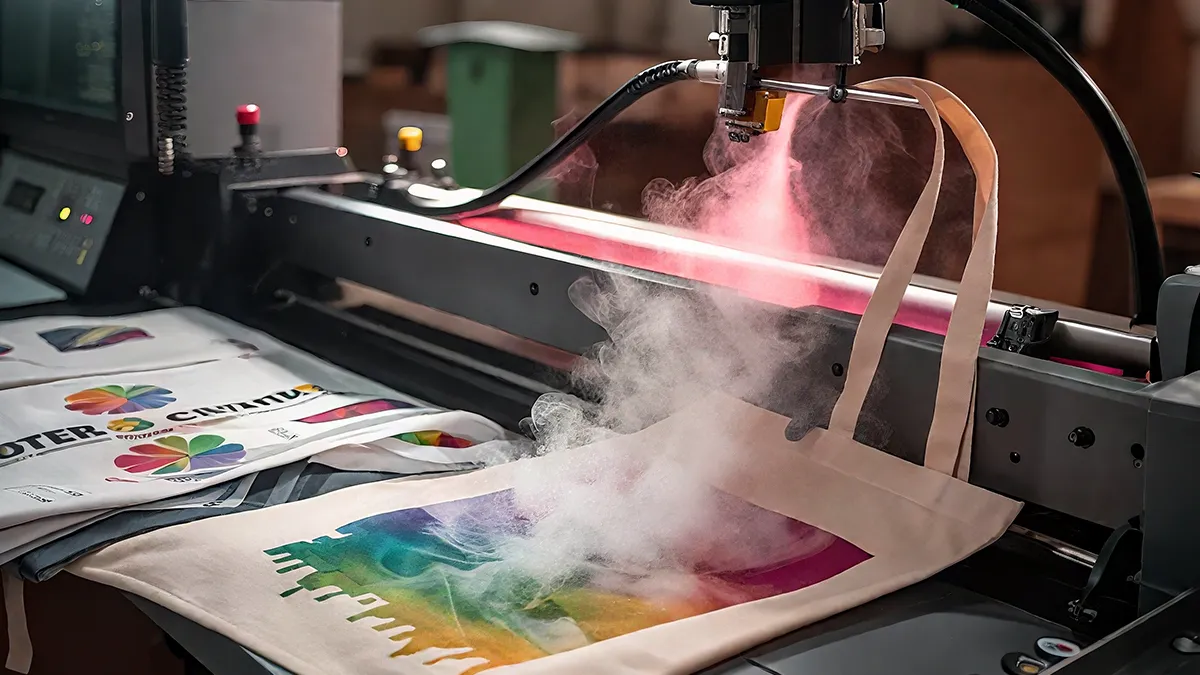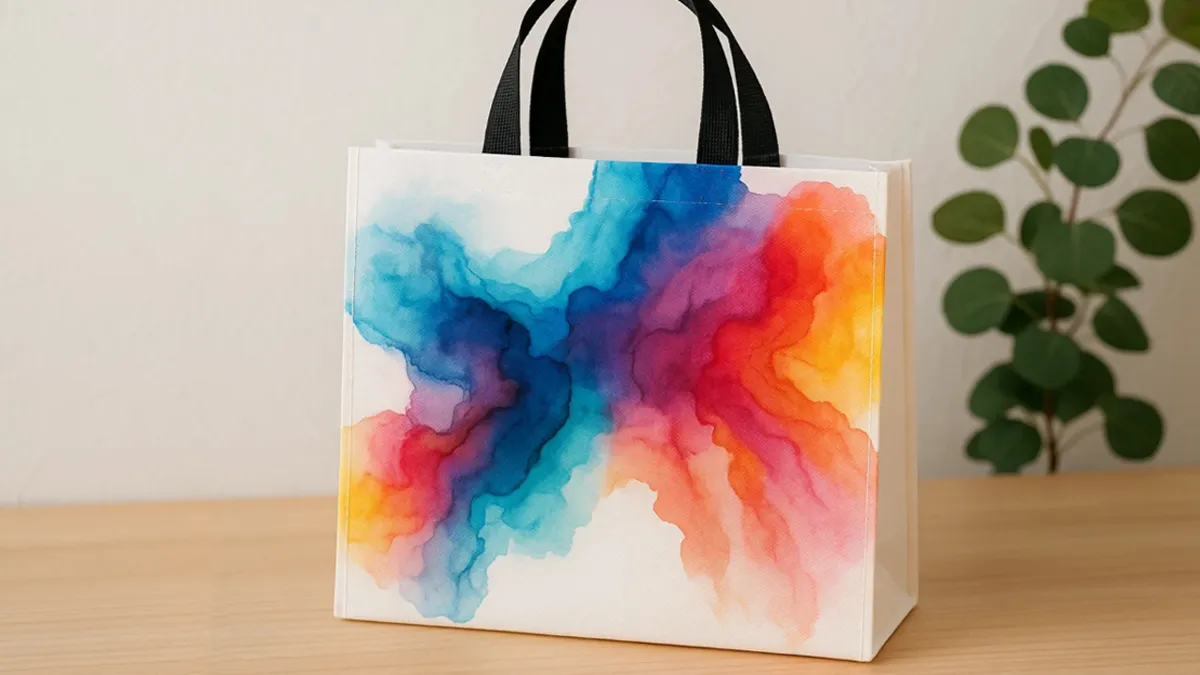If you have ever tried sublimation printing and ended up with faded colors, blurry edges, or even a burned product, you know how frustrating it can be. The truth is, most of these problems come down to one simple thing: sublimation times and temperatures. Get them right, and your prints will come out bright, sharp, and long-lasting. Get them wrong, and you will waste time, ink, and materials.

This matters not only for T-shirts and mugs, but also for products like sublimation tote bags, drawstring bags, and shopping bags. Bags are especially popular for custom printing because they are practical, reusable, and a great way to show off a brand logo or design. But the right heat and time settings are what make the difference between a beautiful bag that customers love and one that looks washed out or uneven.
In this guide, we will break it all down for you—what sublimation printing is, why heat and time are so critical, the standard ranges you should know, specific charts for different products (including bags), common problems and fixes, and some practical tips to help you get perfect results every time.
What Is Sublimation Printing and Why Heat and Time Matter
Sublimation is a special kind of printing where solid ink turns into gas under heat and pressure, bonding directly with polyester fibers or a coated surface. Unlike vinyl transfers that sit on top of the fabric, sublimation becomes part of the material itself. That is why sublimated prints do not crack, peel, or fade easily.
But here is the catch: sublimation only works when you get the heat and time just right. Too little heat and the colors will look pale or patchy. Too much heat and you risk ghosting, scorching, or distorting the material. Press for too short a time and the ink will not transfer fully. Leave it too long and you can burn the design or blur the edges.
This balance is why sublimation times and temperatures are the first thing you need to master. For example, when we sublimate polyester tote bags in our factory, we know that 190–200°C (375–390°F) for about 50–60 seconds is the sweet spot. Any less and the colors look dull, any more and the bag fabric might warp around the seams.
Standard Sublimation Temperature and Time Ranges
There is no one-size-fits-all setting because different materials react differently to heat. That said, most sublimation falls in the range of 190–205°C (375–400°F) for 30–60 seconds.
Here is a quick look at common ranges:
- Polyester fabrics (including bags): 190–200°C (375–390°F), 45–60 seconds, medium pressure.
- Ceramic mugs: 200°C (400°F), 180 seconds, medium to high pressure.
- Metal sheets: 190°C (375°F), 60 seconds, medium pressure.
- Mouse pads: 190°C (375°F), 50 seconds, medium pressure.
- Phone cases: 200°C (400°F), 60 seconds, careful with warping.
Table 1: Sublimation Times and Temperatures (Quick Reference)
| Substrate | Temp (°C/°F) | Time (sec) | Pressure | Notes |
|---|---|---|---|---|
| Polyester Fabric | 190–200 / 375–390 | 45–60 | Medium | Standard for apparel and bags |
| Canvas Tote Bags (coated) | 195–200 / 383–390 | 60 | Medium | Needs sublimation coating |
| Non-woven Bags | 190 / 375 | 40–50 | Medium | Popular for promotional bags |
| Ceramic Mugs | 200 / 400 | 180 | Med–High | Use mug press |
| Aluminum Sheets | 190 / 375 | 60 | Medium | Even heating is key |
Sublimation Times and Temperatures by Product Type
Fabrics (Polyester, Blends, Bags)
Polyester is the superstar of sublimation. The ink bonds directly with the fibers, producing bright, durable colors. For most fabrics, including polyester tote bags, drawstring bags, and shopping bags, 190–200°C (375–390°F) for 50–60 seconds with medium pressure works perfectly.
Things to watch out for:
- If the bag has zippers or thick seams, use a heat press pillow to even out the surface.
- Always pre-press the bag for 3–5 seconds to remove moisture and wrinkles.
- Avoid pressing at too high a temperature, or the bag material might warp.
Hard Surfaces (Ceramics, Metals, Glass)
Ceramic mugs are one of the most common sublimation items. They usually need around 200°C (400°F) for 180 seconds. Metals like aluminum require less time, around 190°C (375°F) for 60 seconds. Always use even pressure for sharp results.
Soft Goods (Mouse Pads, Tote Bags, Pillows)
Mouse pads, tote bags, and pillows all fall into the fabric category, but each has its quirks. Tote bags and pillows, for example, often have seams that can interfere with pressure. Mouse pads are more forgiving. The sweet spot remains around 190–200°C for 50–60 seconds.
Specialty Items (Phone Cases, Canvas Bags with Coatings)
Phone cases and coated canvas bags need a bit more care. Canvas bags in particular often require a sublimation coating to hold the ink. Once coated, they press well at about 200°C (390°F) for 60–70 seconds. Phone cases vary depending on the type of plastic, so always run a test first.
Table 2: Sublimation Times and Temperatures for Bags
| Bag Type | Temp (°C/°F) | Time (sec) | Notes |
|---|---|---|---|
| Polyester Tote Bag | 190 / 375 | 50–60 | Bright colors, smooth surface |
| Drawstring Bag | 195 / 383 | 60 | Double-sided printing possible |
| Non-woven Bag | 190 / 375 | 40–50 | Affordable, great for giveaways |
| Canvas Bag (coated) | 200 / 390 | 60–70 | Needs pre-treatment coating |
Common Problems and Fixes
Even with charts, things do not always go smoothly. Here are the most common issues:
Ink not sticking properly
If the ink just sits on the surface and looks weak, it usually means the heat was too low or the press time too short. Try raising the temperature a little within the safe range or add a few more seconds. Also double-check that you are working with polyester or a coated bag, because sublimation will not bond to plain cotton.
Colors look faded
When colors look dull, the most common cause is under-heating or using the wrong material. Sublimation needs polyester to work properly—cotton or untreated canvas will never give bright prints. Make sure you press at around 190–200°C for 50–60 seconds, and always test on a sample bag first.
Edges look blurry
Blurry edges or ghosting happen when the transfer paper shifts or when you press too long. Always tape the design securely with heat-resistant tape and avoid pressing more than needed. A smooth press and the right timing will keep edges clean and sharp.
Burn marks or melting
If you see scorch marks, shiny spots, or even melting, it means the heat was too high. Non-woven and lighter fabrics are especially sensitive. Stay within the recommended settings and, if in doubt, start at the lower end of the temperature range.
Uneven printing on bags
Seams, zippers, and handles can stop the press from applying even pressure, which leaves faded areas in the design. A heat press pillow can help balance the surface. You can also reposition your design so it avoids seams and prints on the flattest part of the bag.
Tips for Sublimation on Bags

- Always pre-press bags for a few seconds
Before you transfer any design, give the bag a quick press for 3–5 seconds. This helps release wrinkles and moisture that can ruin the print. A flat, dry surface means the ink will transfer evenly and the colors will look brighter. - Use heat press pillows under seams and handles
Bags often have seams, zippers, or thick handles that stop the press from applying even pressure. A heat press pillow balances the surface so the pressure spreads evenly across the design. This way, you avoid faded spots or broken prints near the edges. - Check your designs
Big, bold shapes and vibrant colors look amazing on sublimation bags, while very tiny text or thin lines can get lost in the fabric texture. Always think about how your design will look on the final product—less detail often means more impact. - Tape designs in place with heat-resistant tape
Ghosting happens when the transfer paper shifts during pressing, leaving a shadow or blur. To stop this, tape the paper securely to the bag with heat-resistant tape. It keeps the design steady so every line and color comes out sharp. - Do a sample first
Not all bags react the same way to sublimation—polyester, canvas with coating, and non-woven bags each behave differently. That is why running a small test first is the smartest move. It helps you confirm the best time and temperature before committing to a full batch.
Conclusion
Getting sublimation times and temperatures right is the key to creating prints that look professional and hold up over time. When you work with T-shirts, mugs, or bags, the right mix of heat, time, and pressure decides the outcome. Tote Bags are especially great for sublimation because they are both practical and powerful for branding. With the right settings, you can turn a simple tote or drawstring bag into a bold, colorful piece of merchandise that gets noticed.
At Initi, we design and produce sublimation-ready bags every day—polyester totes, drawstring bags, non-woven shopping bags, and coated canvas bags. We provide OEM, ODM, private labeling, and wholesale services so you can order custom bags with your logo or designs at factory-direct quality.
FAQs
Can you sublimate on tote bags?
Yes, tote bags are one of the best products for sublimation, as long as they are made from polyester or have a special coating. Natural cotton bags do not work unless pre-treated. Polyester tote bags hold color beautifully, and coated canvas bags also produce sharp, vibrant results. At Initibag, we often recommend polyester totes for bulk sublimation orders because they deliver consistent, professional-looking prints.
What temperature is best for polyester shopping bags?
Polyester shopping bags press best at around 190°C (375°F) for 50–60 seconds. This range gives bright colors without damaging the bag fabric. Make sure to use medium pressure so the design transfers evenly across the whole surface. If the bag has thick seams or gussets, use a pressing pillow to avoid uneven spots.
Why does my sublimation print look faded on bags?
If your print looks faded, it is usually one of three things: low temperature, not enough time, or using the wrong material. Sublimation only bonds with polyester, so if your bag is cotton or uncoated canvas, the ink will not hold. Always check the bag material first, then adjust time and temperature within the recommended range.
Can I sublimate on canvas bags?
Yes, but only if they are coated for sublimation. Regular canvas will not take sublimation ink well. With a coated canvas bag, press at about 200°C (390°F) for 60–70 seconds, and you will get sharp, colorful designs. Without the coating, the result will be patchy and dull.
What kind of bags are best for sublimation?
Polyester bags are the best choice, hands down. Tote bags, drawstring bags, and shopping bags made from polyester or polyester blends give the brightest, most durable prints. Non-woven bags also work well for promotional items because they are affordable and take sublimation ink cleanly. Canvas bags need coating, but they can produce a premium, textured look that some brands love.




